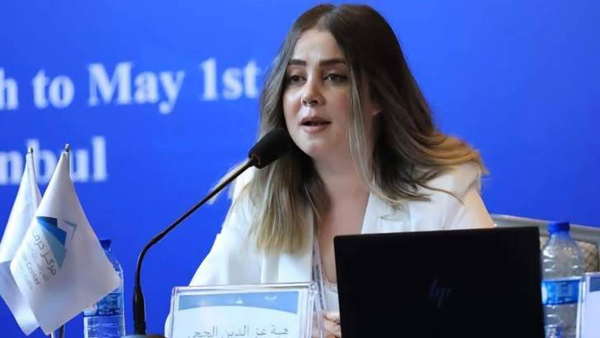Since Abu Muhammad al-Jolani’s group, Hayat Tahrir al-Sham (HTS), seized power in Syria on December 8th of last year, the country has witnessed a surge in kidnappings, particularly targeting Alawite women. Investigations reveal that many of these women are being taken to Idlib, the stronghold of HTS, where they are subjected to sexual slavery. This phenomenon echoes the mass abduction of Yazidi women by ISIS in Iraq in 2014, who were similarly forced into sexual servitude.
Revelations from a Syrian Human Rights Activist
Hiba Ezaldin Al-Haji, a Syrian human rights defender and head of the Justice and Empowerment Organization as well as the Shahan Network for Peacebuilding, shared a troubling account on Facebook before deleting it due to threats from HTS. She recounted meeting a woman who had been abducted during the massacre of Alawites in Syria’s coastal region in March.

Ezaldin wrote: “During my recent trip to Idlib with my brother, I encountered a man I recognized. He was with a woman I hadn’t seen before. I knew he had married multiple times and already had three wives. What caught my attention was the woman’s appearance—she clearly didn’t know how to wear a hijab properly.”
Further investigation revealed that the woman came from Syria’s coastal region, which witnessed the brutal killing of over 1,600 Alawites by HTS fighters in March. Ezaldin added: “After bringing her to Idlib, the man married her. No one knows about her situation, and attempts to contact her have failed due to fear of her circumstances.”
This encounter sparked Ezaldin’s field research into the abduction of Alawite women from the coastal region. She noted: “Unfortunately, many confirmed the accuracy of this issue. It’s not just one armed group—it’s also foreign militants, including those affiliated with the Turkish-backed National Army, who are involved in such crimes.”
The Role of Jolani’s Regime
Since consolidating power, Jolani has integrated extremist groups like the Turkestan Islamic Party and Syrian Turkmen factions under HTS command. These groups participated in massacres against Alawite communities in March, raiding villages, looting homes, killing men and children, and abducting women.
Ezaldin ended her post with a warning: “What is happening in Syria is extremely dangerous. Jolani’s regime must act to clarify the fate of these women and secure their release.” Instead of investigating, the authorities in Idlib issued an arrest warrant for Ezaldin, accusing her of insulting the hijab.
A Pattern of Abductions Across Syria
Before this, similar incidents occurred elsewhere in Syria. On February 2nd, Karolis Nahli, a young Druze woman, was abducted near Jaramana in Damascus. Unlike typical kidnappings for ransom, there was no demand for money, and rumors suggested she was taken as a slave to Idlib—a claim supported by Ezaldin’s findings.

On March 21st, Basharri Bassin Mafraj, a 32-year-old Alawite mother of two, was abducted at a bus station in the coastal city of Jableh. Her husband posted videos online stating his wife had been taken to Idlib, calling it the worst possible fate for any spouse. This incident triggered a wave of abductions. According to the Kurdish news agency Jinha, more than 100 people were kidnapped within 48 hours, many of them women.
Other victims include:
- Katya Jihad Qarqat, 21, abducted on April 5th after leaving a pharmacy in Artooz, near Damascus.
- Samia Suleiman Hasno, 17, taken after leaving school in Qardaha, near Latakia.
- Ranim Ghazi Zariqa, 22, disappeared in Masyaf, Hama province.
- Batoul Aref Hassan, a mother of a three-year-old, abducted while returning home from her parents’ house along the Homs-Safita road.
- Ayah Talaal Qasem, 23, abducted in Tartous and later arrested by HTS despite being released by her captors.
Echoes of Sinjar’s Horrors
On April 17th, the Iraqi website Aldaraj published details of ten Alawite women abducted from Syria’s coastal regions and surrounding areas. One victim, using the pseudonym “Rahab,” described being kidnapped in broad daylight and imprisoned with another woman. She recounted: “We were tortured and forbidden to speak. From their accents, I realized they weren’t Syrian—one spoke with a foreign accent, and the other was from Idlib. They insulted us because we’re Alawite.”
Another abducted woman reported being forced to call her family, assuring them she was fine while urging them not to report her kidnapping. In another case, an 18-year-old girl abducted from a coastal city later contacted her family using a number linked to Ivory Coast, claiming she was safe but unaware of her location.
Aldaraj emphasized that the plight of these Syrian women mirrors that of thousands of Yazidi women abducted by ISIS in Sinjar in 2014. At the time, ISIS captured around 6,400 Yazidi women, selling some into slavery or training others as suicide bombers. While many escaped, the fate of approximately 2,600 remains unknown even a decade later.
HTS Steps Into ISIS’s Shoes
Reports of Alawite women enslaved by HTS come as no surprise, given the group’s ideology aligns closely with ISIS’s view of religious minorities. In 2014, analyst Sam Heller described Jabhat al-Nusra (HTS’s predecessor) as promoting sectarianism and encouraging massacres of Alawites. Both ISIS and HTS consider Alawites apostates.
When ISIS collapsed, some Yazidi survivors revealed that women and children had been trafficked from Iraq to Syria and Turkey. The Guardian reported in 2019 that Yazidi women were held in prisons in Idlib and northern Aleppo, corroborated by Alexander Hague, head of the International Commission on Missing Persons in Iraq.
In 2019, Ali Hussein, a Yazidi from Dohuk, recounted paying $70,000 to rescue an 11-year-old Yazidi girl sold to a Jabhat al-Nusra leader. Similarly, Reuters documented the story of Rozhan, a Yazidi girl abducted at age 13 and kept as a slave by a Saudi ISIS fighter in Idlib for five years.
Jolani’s Regime: A New Face of Oppression
Just one day after HTS took control of Damascus, the Kurdish news network Rudaw reported the liberation of a 29-year-old Yazidi woman held captive in Idlib. The network highlighted that many Yazidi women remain in detention under militant groups, beyond the infamous al-Hol camp.
While major Syrian cities celebrated the fall of Assad’s regime and Jolani’s rise to power, the true nature of his rule soon became apparent. The wave of abductions targeting Alawite women for enslavement mirrors ISIS’s atrocities against Yazidis, exposing the grim reality behind Jolani’s so-called liberation of Syria.
Fars


